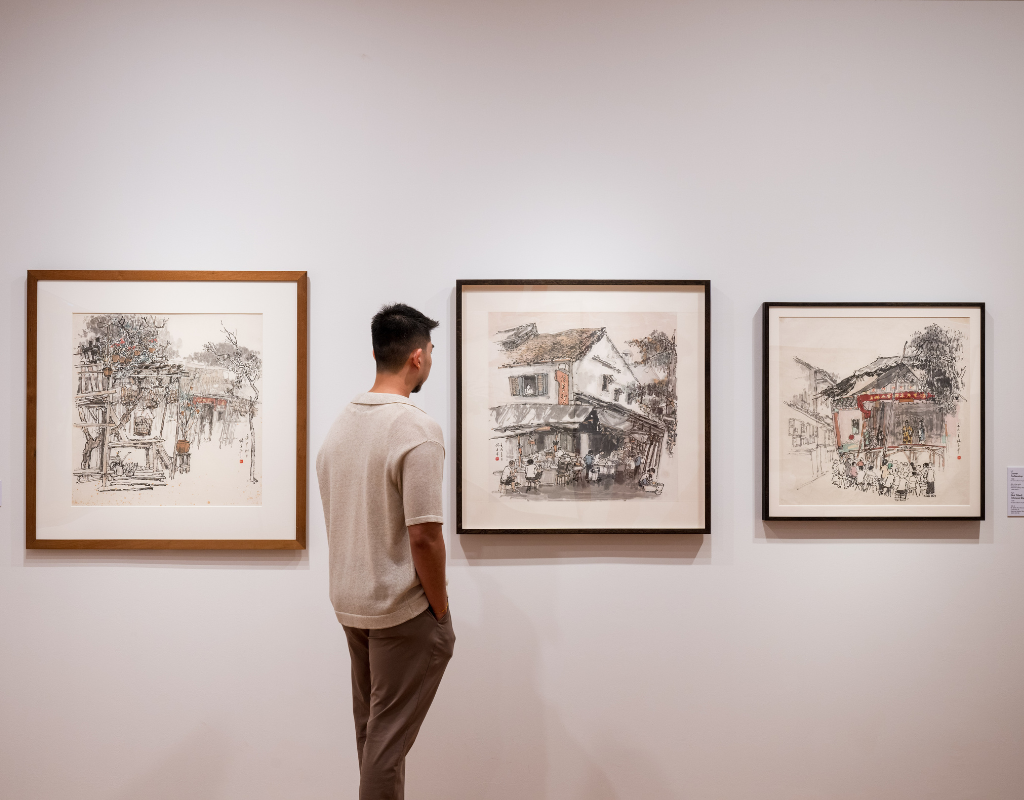Similarities you never knew between Southeast Asia and Latin America unpacked at the world’s first major comparative art exhibition of both regions
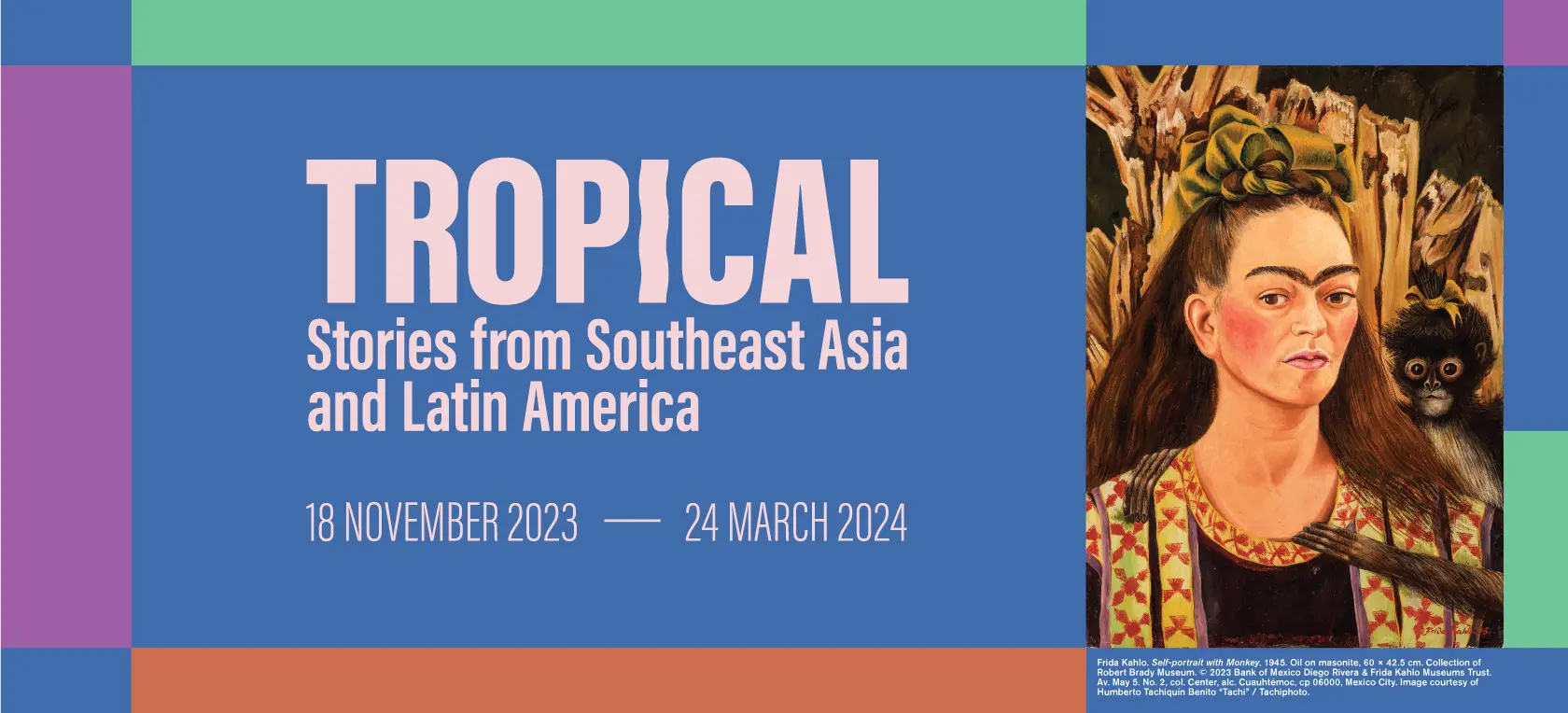
Singapore, 15 November 2023 – Uncover shared connections between the seemingly distant realms of Southeast Asia and Latin America with National Gallery Singapore’s latest blockbuster exhibition, em. Opening on Saturday, 18 November, it is the world’s first major comparative exhibition of artistic expressions from both regions, featuring over 200 artworks, sculptures, drawings, performances, and immersive installations by more than 70 artists, encompassing the breadth of the 20th century. The exhibition extends across three galleries, each exploring distinct themes: The Myth of the Lazy Native, This Earth of Mankind, and The Subversive. Additional details can be found in the annex.
Whether savouring curry puffs in Singapore or indulging in empanadas in Mexico, navigating the rice paddies of Bali, or exploring the sacred valleys of Peru, it might surprise many to discover the stark similarities between these two regions. From climate and culture to food, attire, sports, and history during the colonial period, the parallels are striking. Through Tropical, the Gallery invites visitors to venture across space and time to gain a first-hand look at the artists’ shared stories and experiences since the 1920s. They stand in solidarity against a common challenge and yet defiantly reclaim their place within the story of art. Narrowing the distance between the two distant regions, this breathtaking journey will be guided by the works of cultural icons and luminaries such as Frida Kahlo (Mexico), Helio Oiticica (Brazil), Latiff Mohidin (Malaysia), Cheong Soo Pieng (Singapore), and more. Audiences will also be treated to an extraordinary museum-going experience with “floating” artworks, “wearable” installations, and interactive experiences that spill outside of the galleries into public spaces. Visitors can also immerse themselves in a large-scale installation that has birds, plants, sand and more.
Dr. Eugene Tan, Director of National Gallery Singapore, says, “Tropical: Stories from Southeast Asia and Latin America is a pivotal exhibition that has been years in the making, and we are thrilled to be able to present it on such a scale. By focusing on affinities between 20th century Southeast Asian and Latin American artists, the Gallery spotlights the innovative ways through which they sought to stake a claim for art and representation on their own terms. Tropical embodies the Gallery’s efforts to drive a greater understanding of Southeast Asian art, its histories, and connections to global art histories. We hope that this exhibition will contribute to ongoing discourses on the reframing of modern art, made possible with the support of artists, colleagues, and valued partners around the world.”
Mr Yuen Kuan Moon, Singtel’s Group Chief Executive Officer says, “For over 140 years, we have been connecting communities across the world, empowering generations of people to bridge geographical distance to share their experiences and build stronger relationships. Despite being quite literally on the opposite side of our planet, Latin America, with its rich cultural tapestry, shares many remarkable similarities with the people in Singapore, including incredibly diverse societies and a history shaped by colonialism. Through Tropical: Stories from Southeast Asia and Latin America’s iconic works of art at the Singtel Special Exhibition Gallery, we hope to help visitors explore the commonalities that bind us and spark meaningful new connections that transcend continents.”
Embracing the defiant attitude called “Tropical”
Tropical: Stories from Southeast Asia and Latin America explore the vibrant narratives of artists, dreamers, and writers who sought to become the new torchbearers of modern art by the 1950s, as self-determination took root. They believed they had a distinct advantage over their colonisers, possessing an equal ability to paint, speak and write while responding to the issues of the time and the desires of their people.
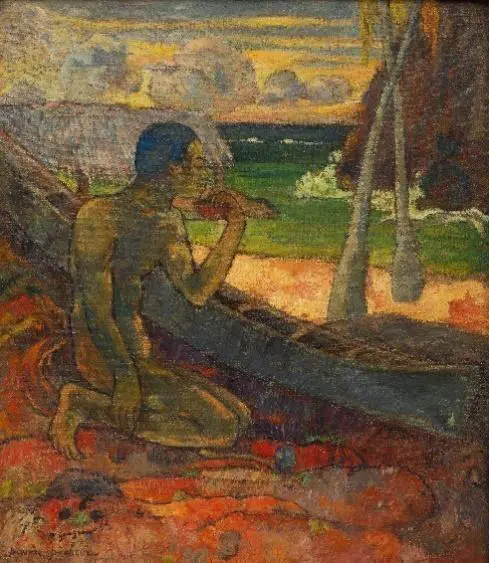
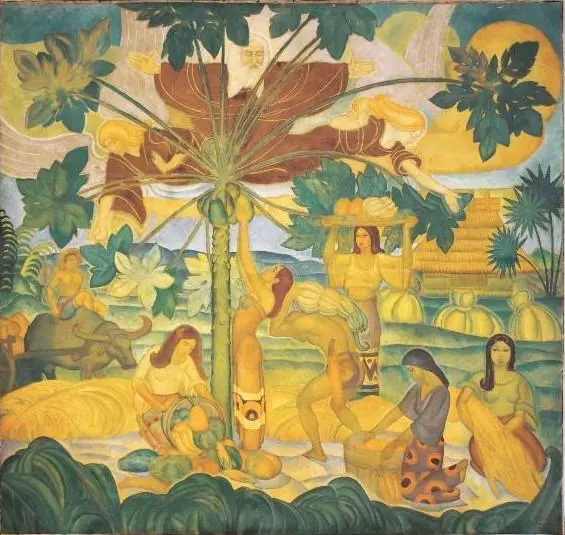
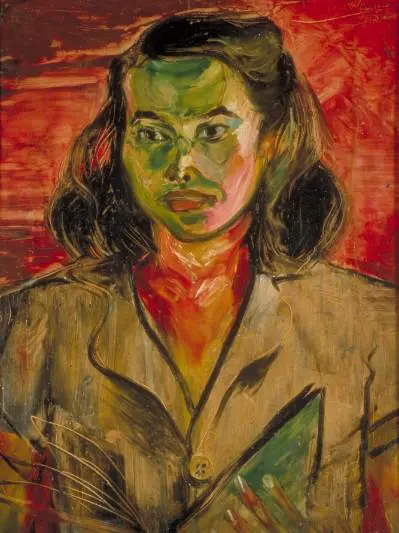
These nationalists asserted their identity by challenging colonialist stereotypes popularised by famous artists such as painter Paul Gauguin (France), who was obsessed with fantasies of an equatorial paradise teeming with uninhibited, carefree “natives” and lush landscapes. Visitors are encouraged to closely examine each artwork, where they will find labourers, fruit sellers, freedom fighters, and even wives and mothers as protagonists, as artists sought more truthful representation in their art.
Meet the regions’ greatest cultural icons all in one place
Tropical takes an unfiltered look at some of Latin America and Southeast Asia’s seminal artists from the 20th century. For instance, the late Frida Kahlo from Mexico is widely celebrated in the art world and continues to live on in popular culture as an empowering feminist icon. Displayed in Singapore for the first time, her Self-Portrait with Monkey reveals her ongoing personal struggles, including the chronic pain she endured. The spider monkey symbolises the children she was unable to bear due to her medical conditions, while the Tehuana Huipil, a traditional handmade blouse, signifies her identification with the matriarchal societal structure of Zapotec women from the Isthmus of Tehuantepec in Mexico.
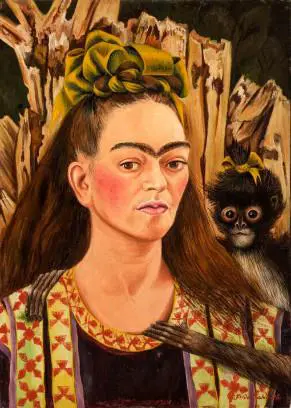
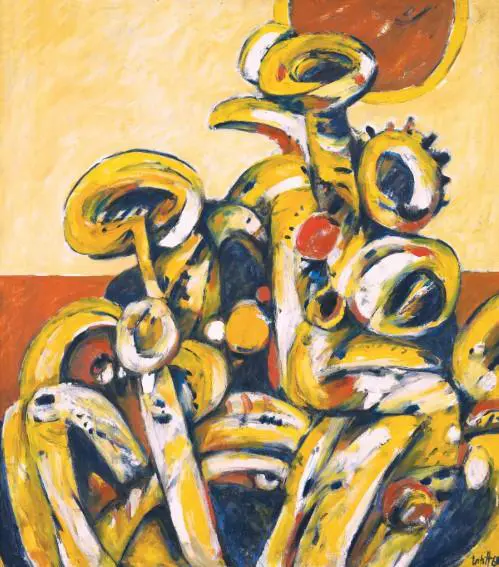
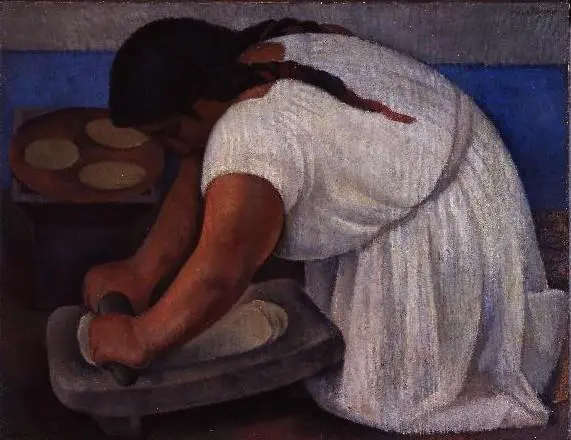
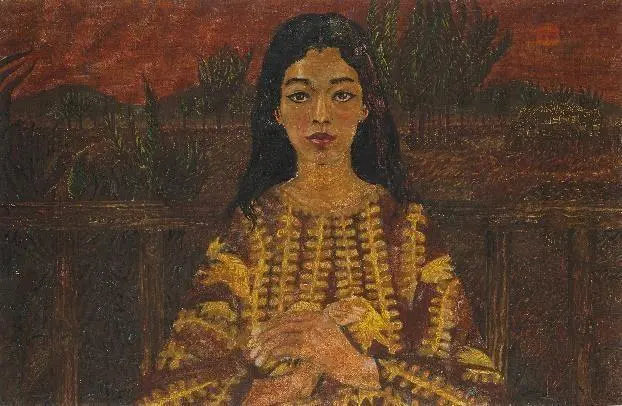
Latiff Mohidin is Malaysia’s most cherished painter and poet. In the 1960s, he embarked on an extraordinary journey across Southeast Asia and coined a phrase “Pago Pago”, a way of thinking and working that sought to challenge the dominance of Western modernism at that time. Latiff Mohidin’s Tumbuhan Tropika (Tropical Growth) depicts a vegetal mass becoming entangled with itself as it reaches for the sun. The growth appears to be the act of uniting, adding tension, and physically joining separate and overlapping forces. Both regions saw a renaissance in the 20th century, with talented artists and thinkers from opposite ends of the world pushing the fold of how art can be a means of social change.
Extraordinary exhibition experience unlike any other
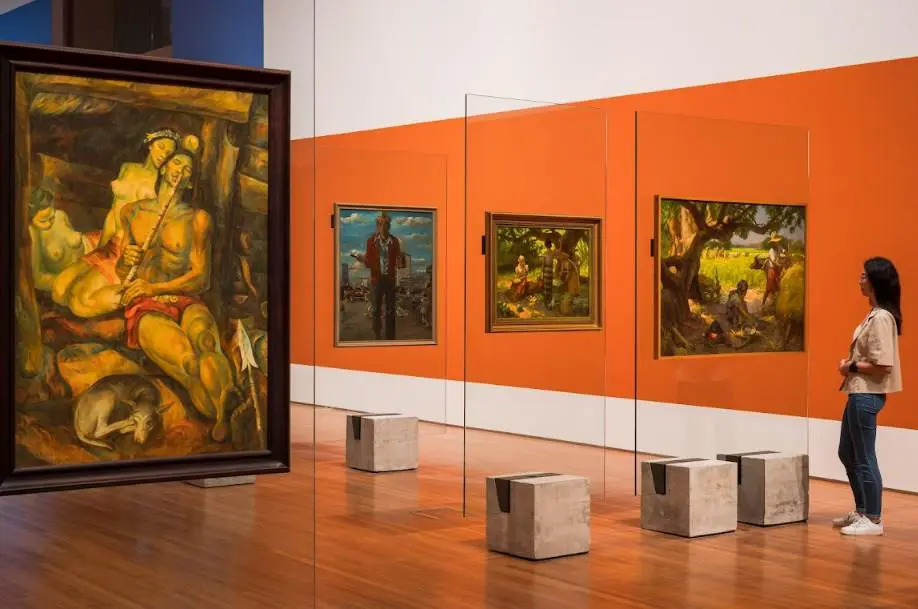
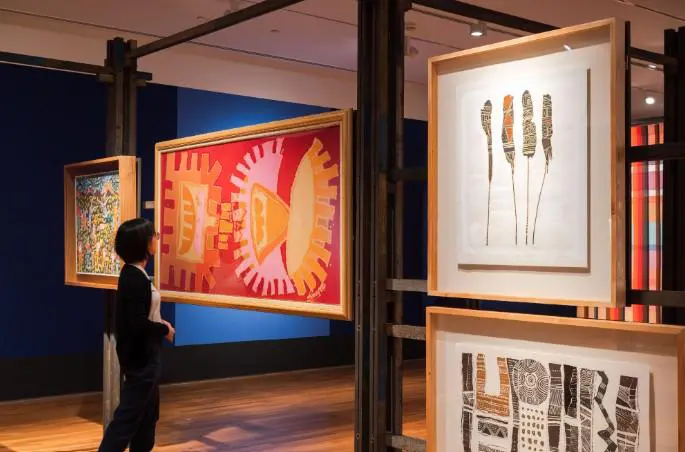
Installation view, Tropical: Stories from Southeast Asia and Latin America, National Gallery Singapore, 2023.
Departing from conventional methods of displaying art on the walls of a white cube, most of the artworks in Tropical are showcased either on glass “crystal easels” that create the illusion that the artworks are “floating”, or on a grid system using recycled timber planks from Singapore’s Jurong Shipyard. Each gallery encourages visitors to be social - by breaking the typical, one-directional viewing experience with the flow of people cutting across the displays, heightened due to adapted systems from legendary Italian-born Brazilian architect Lina Bo Bardi; or through the introduction of mirrors and audio-visual elements for a shared moment of contemplation and selfies.
Immerse yourself in a large-scale installation that has birds, plants, sand and more
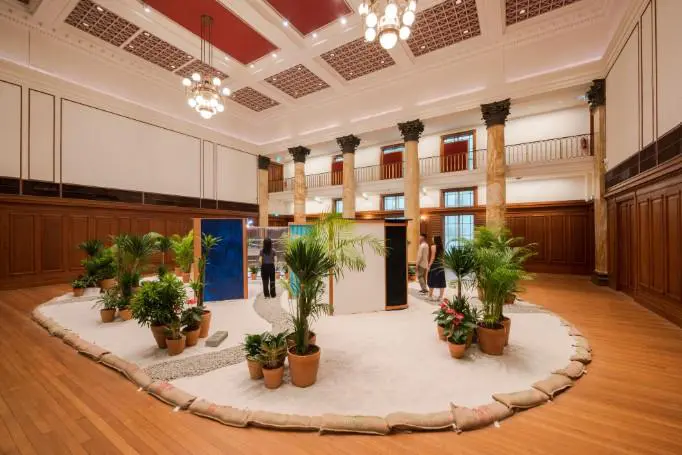
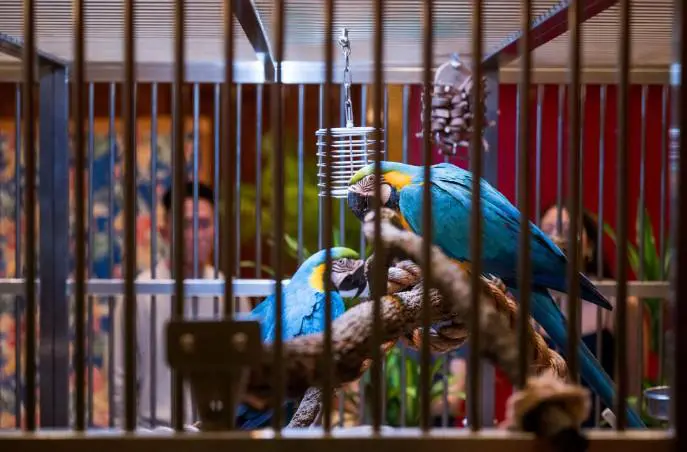
Tropical engages the senses in diverse ways. Making its Southeast Asian debut, Hélio Oiticica’s Tropicália is set within the historic City Hall Chamber. Throughout the exhibition duration, visitors can interact with the installation that features macaws, concrete slabs, plants, sand, and wooden structures the way they wish to. Audiences are also encouraged to engage in a multi-sensorial experience as they ponder and challenge stereotypes of a “tropical paradise”.
Wear, feel, and participate
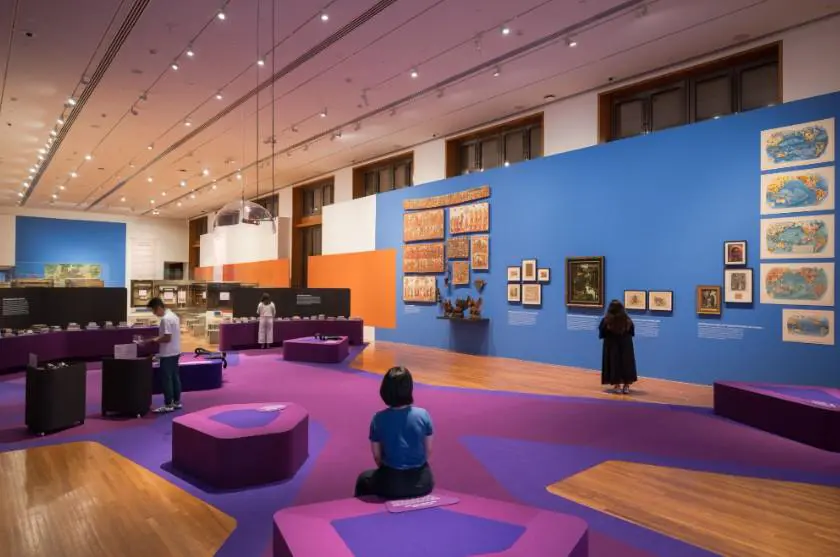
Visitors are encouraged to immerse themselves in an intriguing collection of books, films, paintings, posters and cultural objects revolving around the islands of Bali and Tahiti and reflect upon the compelling troubling intersections that persists between modern art, mass tourism, and their combined appetite for the exotic.
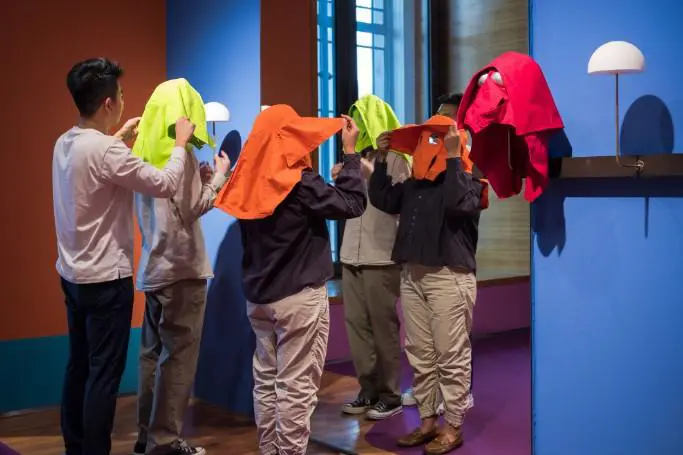
Participants’ sight will be obscured by heavy canvas while other stimuli are introduced, such as the aroma of cloves or the touch of shells.
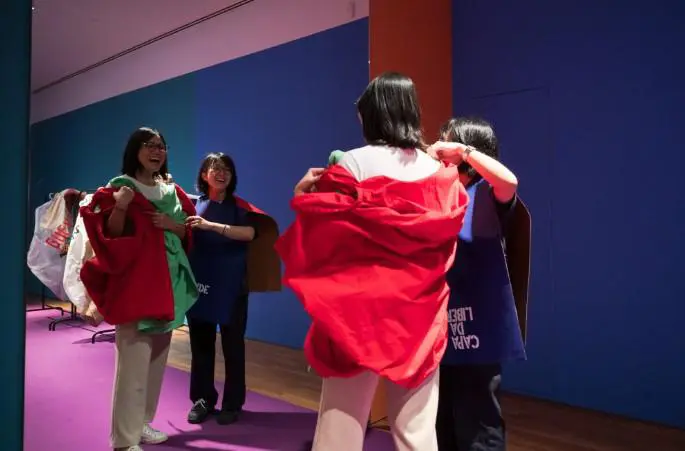
Audiences can try on iconic wearable capes as they move through the exhibition.
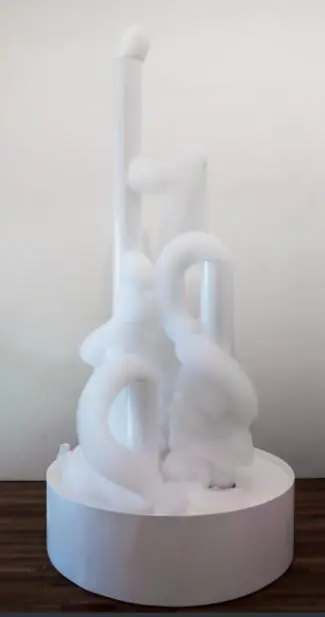
Visitors can observe how Medalla’s Cloud Canyons give tangible form to invisible forces, through this work which is popularly known as a “bubble machine”.
Gallery-wide activation
Tropical: Stories from Southeast Asia and Latin America run from 18 November 2023 to 24 March 2024 at Singtel Special Exhibition Gallery, with activations that are free for public viewing at Singapore Courtyard and the Gallery’s Coleman Street Entrance. Standard Special Exhibition Passes are available at $25 ($15 for Singapore residents). Gallery Insiders enjoy free unlimited access to the exhibition. Tickets for Tropical: Stories from Southeast Asia and Latin America are now available at an early bird discount of 10% off till 31 December 2023 when tickets are purchased online. More information on the promotions can be found in the Annex.
Visitors to Tropical can also use their tickets to redeem and enjoy Tropical-themed beverages. Over at The Great Mischief, the first 200 Tropical ticketholders daily will be able to enjoy a free cup of coffee with beans sourced from Latin America during the opening weekend of 18 and 19 November, while those who fancy a tipple can enjoy 15% off Tropical-inspired cocktails at Smoke & Mirrors for the duration of the exhibition. Visitors who present their Special Exhibition or All Access tickets at The Gallery Store by Abry will also enjoy 10% off Tropical-themed merchandise.
More information can be found in the following annex or you may visit nationalgallery.sg/Tropical. Media assets are available via this link.
- Annex A: Tropical Exhibition Highlights
- Annex B: Tropical Exclusive Promotions
- Annex C: Tropical Exhibition Programmes
Annex A: Tropical Exhibition Highlights
Gallery 1: The Myth of the Lazy Native

Victorio C. Edades is a defiant figure within the story of modern Philippine art. In 1938, he founded the Thirteen Moderns with Carlos “Botong” Francisco, Galo Ocampo, Vicente Manansala and others. The group eschewed pastoral motifs prevalent in Filipino painting at the time. Instead, they embraced emerging internationalist forms and brought them into dialogue with everyday Filipino struggles. In particular, they turned to muralism as it enabled them to tell the story of the Philippine Revolution while enacting the shared experience of formerly colonised Hispanic peoples in Latin America.
Edades’s polemics against pastoralism culminated in a dramatic and oft-cited clash: Fernando Amorsolo and his acolytes walked out in protest after several of the Thirteen Moderns won awards at the 1955 Art Association of the Philippines annual exhibition, for their symbolic representations of workers on whom rested the spirit of industrialisation and postcolonial modernity.
Mother Nature’s Bounty Harvest (1935) is an iconic work by Edades, Botong and Ocampo. The three artists frequently collaborated on murals for new public spaces in the rapidly urbanising city of Manila, earning themselves the moniker the “triumvirate of modern art.” Painted for an art patron’s residence, Mother Nature’s Bounty Harvest is representative of the themes and style that the artists deployed in their public murals. This work is one of the few pieces by the trio to have survived World War II. However, several murals by Botong remain, including the approximately 80-metre-long Filipino Struggles through History (1964), and are in the collection of the National Museum of Fine Arts in the Philippines.
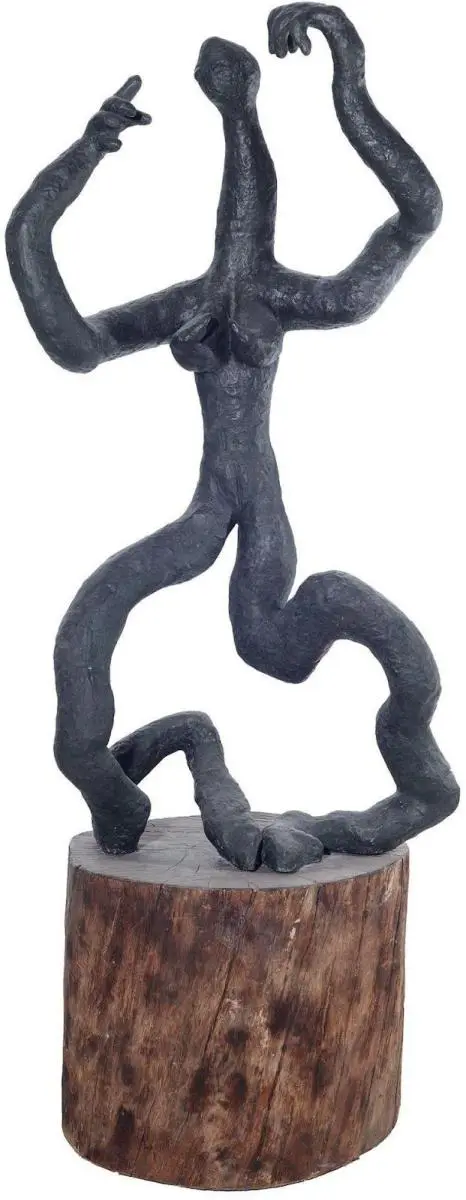
Maria Martins was born in Minas Gerais, southeastern Brazil, a region known for its rich Afro-Brazilian cultural heritage. Though she primarily sculpted in bronze, Martins only garnered recognition in Brazil after making a name for herself in Paris, where she interacted with Surrealists like Marcel Duchamp. Martins set herself apart by drawing from Amazonian Amerindian mythologies, playing to the exoticism that captivated her European peers. Yet, she often found her works labelled as “too foreign” for Brazil and “too Brazilian” for global spectators.
Comme une liane is made of bronze, with its plant-like limbs suggesting a fluid, yet strong sense of a being transformed from within. By reimagining visual codes, Martins not only projects a distinctly Latin American future in both source and spirit, but also intertwines ideas of mimicry in nature and the body to rethink notions of gendered representation.
Martins was among the founding members of the Museu de Arte Moderna do Rio de Janeiro—which was established in 1948—and played a crucial role in co-founding the São Paulo Biennial in 1951.

Hendra Gunawan was a painter and activist who played a pivotal role in the evolution of modern art in Indonesia. Gunawan was associated with various artist associations all throughout his life. In the 1940s, drawn to wayang golek puppetry from West Java, he founded the Pusaka Sunda (Sudanese Heritage) Association. Simultaneously, he joined Sukarno’s anti-Japanese movement, Pusat Tenaga Rakyat (Putera, Centre of the People’s Power). Sukarno later became Indonesia’s first President.
After the end of the Second World War in 1945, Gunawan fought against the Dutch as a member of Pelukis Front (Painter’s Front) and Pelukis Rakyat (People’s Painters). He was also instrumental in Lembaga Kebudayaan Rakyat (Lekra, Institute of People’s Culture), which was closely linked to Indonesia’s leftist movement. This affiliation ultimately resulted in his arrest due to his involvement in the Thirtieth of September Movement in 1965. Despite this, Gunawan persisted in painting during the 12 years he was imprisoned, creating works with vivid colours and fluid forms that consistently challenged the boundaries of the medium.
These revolutionary impulses were mirrored in Gunawan’s art. He chose to depict everyday subjects and developed a style that drew inspiration from the flat, elongated forms of Javanese puppets. Additionally, he employed vivid colours, prioritising expression and impact over realism. In the introspective portrait Tjitji, a freedom fighter flips through a pamphlet, her gaze extending beyond the canvas’s confines. The uncanny green of her face contrasts against a swirling red sky, underscoring the unease and necessity for resilience amidst an uncertain future.

Diego Rivera was a leading figure in the project of muralism in the 1920s in Mexico. Planned for public spaces such as municipal and state buildings, educational institutions, and religious spaces, the murals presented narratives that foregrounded Mexico’s deep history of indigenous knowledge and culture. The murals also retold Mexico’s history as a triumphant struggle over its many aggressors and provided space to imagine a technological and industrial future of progress. Here, Rivera embodies the same impulses of his murals through overlapping forms of working-class figures. The flatness of the composition harks to the muralists’ enduring engagement with their works’ main support, the wall, translated here onto the canvas.
Gallery 2: This Earth of Mankind

Working in the 1950s, Patrick Ng Kah Onn developed a consciousness towards the nascent formation of a Malayan cultural identity after three centuries of colonial rule. With a daring embrace of self-portraiture and an application of techniques from the Malay world such as batik, Ng traversed these burgeoning concerns to offer a profound insight into what could become a modern vision of cultural expression in soon-to-be Malaysia.
In Patrick Ng’s Self-Portrait, as he reimagines himself as a long-haired, Malay female clad in batik. The inclusion of batik here signifies amelding of old traditions with new adaptations, aprofound representation of Malayanisation, a sociopolitical programme that sought to establish a “homogenous” identity in the soon-to-be independent nation.
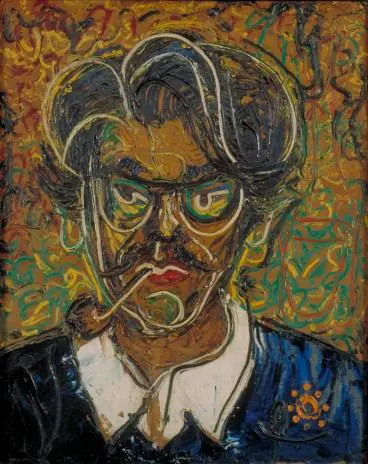
Bagyi Aung Soe was part of a wave of painters from the 1950s to 1970s who attended Rabindranath Tagore’s Visva-Bharati University in Śāntiniketan, India. There, he was exposed to the poet Rabindranath Tagore’s pan-Asian ideals. After returning to Burma (today, Myanmar) in 1952, Aung Soe travelled his home country to learn about popular artforms such as wood carving and lacquer painting. This experience complemented his exposure to various popular and folk art forms at Śāntiniketan.
Aung Soe envisioned himself as a bridge between old traditions and new ideas in art, laying the ground for modern Burmese art that integrated both. This integration is evident in how Aung Soe frequently used Burmese arts and crafts as subjects.
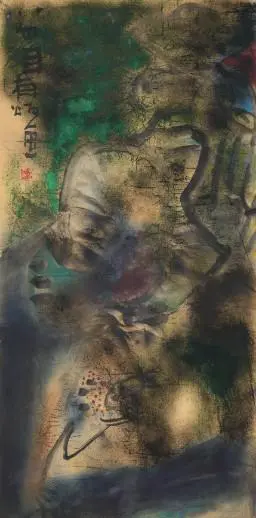
Tan Oe Pang is acclaimed for his interpretation of Chinese ink aesthetics across diverse styles and mediums. After training under the classical ink artist Fan Chang Tien in Singapore, he rapidly forged his own artistic language, continuously exploring newer methods of advancing the medium of ink. A versatile artist, his art spans calligraphy, figurative and abstract compositions in ink, as well as oil works on canvas and aluminium. In the 1980s, Tan played a pivotal role in shaping the art education syllabus in Singapore.
In 1985, Tan’s Insect of Ice was presented at the prestigious 18th São Paulo Biennial in Brazil. He was was invited to contribute to the International Biennial of Arts Valparaiso, Chile in 1989. With his submission of Woman in Struggle, Tan became the first ink artist to be featured at this event.
Tan’s interest in locating the links between life and art resulted in expressive colour and bold line work, drawing parallels between the fluidity of the world around us and the singularity of line in ink painting. In his compositions, Tan frequently cites Afro-Cuban artist Wifredo Lam's hybrid beings—figures that blend human, animal, and vegetal elements—as a pivotal reference in his art. Works by Lam can be seen in the next gallery.
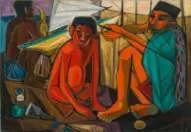
Cheong Soo Pieng was a central figure associated with artists in Singapore and Malaysia in the 1950s and 1960s. Cheong’s art combined classical Chinese ink aesthetics with the nuances of Impressionism, Cubism and expressionism, which he had acquired from his training in China during the 1930s. After settling in Singapore in 1946, Cheong immersed himself in the cultural fabric of the Malay world, journeying across the newly established nations of Indonesia and Malaysia. Paying keen attention to material culture and crafts, architecture and urban landscapes, he cultivated a distinct and progressively stylised approach to figuration.
[Not titled] (Lumba Jong) is a striking example of Cheong’s early ventures into colour, line and composition. The faces of the central figures are reminiscent of ceremonial masks, likely drawing inspiration from Javanese or Balinese theatre. In Malay, lumba jong refers to a lightweight sailing boat. Racing these jongs was a significant social pastime in Singapore that lasted wellinto the 1970s, and people would gather along the coastline to compete with their crafted boats. The formal experimentation in the painting speaks to Cheong’s aspiration to cultivate a distinct vocabulary capable of capturing the essence of this cherished craft tradition.
Gallery 3: The Subversive

Lygia Clark’s masks integrate art with sensory exploration. Made of heavy canvas, they obscure the sight of the wearer while introducing other stimuli, such as the aroma of cloves or the touch of shells. Just as masks have historically allowed individuals to adopt new identities and transform like mutants, each of Clark’s mask prompts self-reflection and heightened self-awareness.
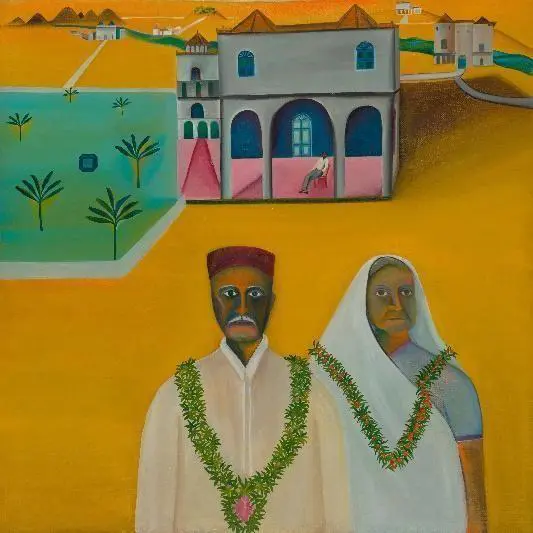
Bhupen Khakhar’s astute depictions explore the way modern life intersects with pageantry and popular rituals, illuminating society’s drive to maintain social appearances. At first glance, the painting seems to portray the artist’s parents embarking on a pilgrimage. Yet, it is a work that is fraught with contradictions. Khakhar’s father died when the artist was four, yet the painting shows him as an imagined projection. The figure of the mother is missing her bindi, a sign that she is a widow. Additionally, the artwork shows the family home while an adult Khakhar stands on the patio dressed in office attire.
Khakhar’s interplay between the house, symbolising material wealth, with the pilgrimage, emblematic of worldly renunciation, underscores a central conundrum of modern existence: the desire to possess and renounce material goods.
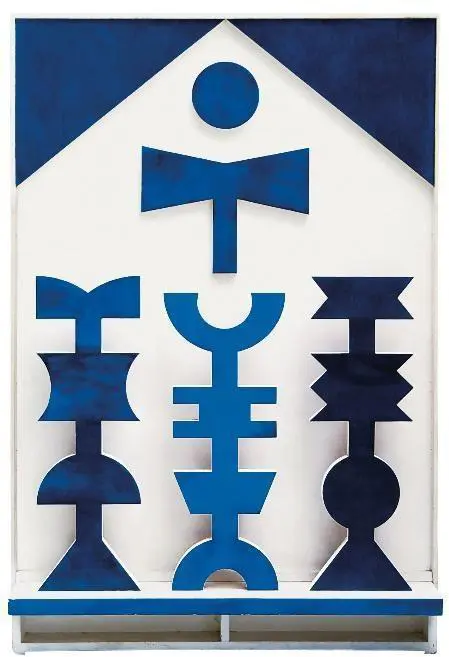
Rubem Valentim combined geometric patterns with symbols from Afro-Brazilian religMions like Candomblé and Umbanda, which synthesise West-African customs with indigenous Brazilian practices. He frequently drew inspiration from orixás—revered deities that symbolised natural forces and ancestral spirits—using them to craft intricate, stacked permutations. In 1966, Valentim began constructing sculptural reliefs using 15 recurring symbols. Objeto Emblematico 1 exemplifies this shift in his practice, with the meticulous application of blue and white paint onto stacked symbols that evoke a totemic quality.
The work offers a glimpse into Valentim’s life-long quest in channelling the intangible realms of Afro-Brazilian thoughts and experience through the transformation of abstract forms.
City Hall Chamber

Originating in Brazil in the late 1960s, the Tropicália movement celebrated the country’s culture, merging music, art and writing. While music is often the focal point when discussing Tropicália, the visual arts played a pivotal role. “Tropicália“ is also the title of a song by celebrated Brazilian musician Caetano Veloso.
The word “Tropicália” was first coined by the artist Hélio Oiticica, who used it as the title for one of his most iconic interactive artworks. Tropicália was presented for the first time in Rio de Janeiro in 1967. At first glance, the artwork paints Brazil as a vivid tropical haven replete with sand, palms, live birds and vibrant makeshift structures. But as one delves deeper, a poignant irony emerges. These structures echo the architectural nuances of Rio de Janeiro's favelas or informal settlements, presenting a stark juxtaposition between idyllic stereotypes and the harsh realities of life.
Through this installation, Oiticica navigates the fine line between celebration and critique of the trope of a tropical paradise. The artwork serves as a stage where myth and reality can dance together, compelling the onlooker to step into a realm where perceptions are constantly challenged, and everything is more than it seems.
Singapore Courtyard
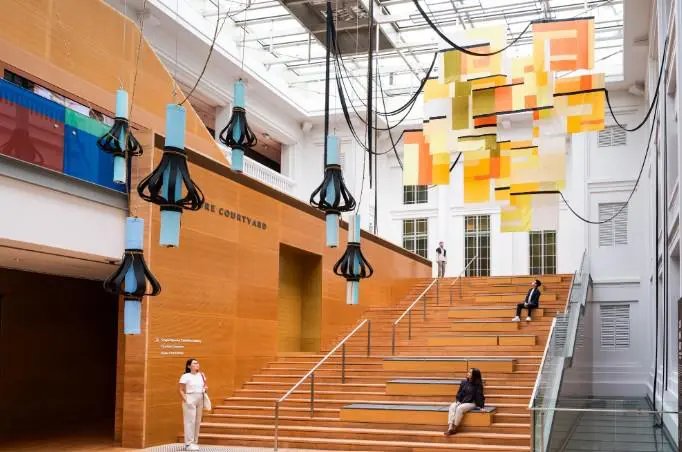
Vientos Alisios consists of two parts. The first is Tigresses, a set of ten handsewn banners composed in a precise, overlapping formation. The text on the banners shifts as you move through this space. Tigresses explores the ecological phenomenon of disruptive colouration, a camouflage strategy employed by animals that conceals them from predators. From certain vantage points, the word “Tigresses” emerges, almost like an incantation, reminding us that language carries with it the potential to unlock realms beyond our grasp.
Swaying gently beside them are the Trees, a collection of vertically suspended canvas cylinders. These are not just canvases; they act as portals, each crowned with propulsion-like pods made of dark rubber. Bathed in varying shades of ethereal blue, they beckon with tales of Á Bao A Qu, the tentacled mythological being from the pages of The Book of Imaginary Beings. Penned by the Nobel Laureate Jorge Luis Borges, the book describes Á Bao A Qu as a radiant blue creature that trails behind pilgrims as they journey upward towards the Vijaya Stambha (Tower of Victory) within the ancient walls of Chittor Fort in Rajasthan, India. In this space, myth and reality dance together, inviting onlookers to step into a world where everything is more than it seems.

David Medalla created the first Cloud Canyons artwork in 1964, and it is considered a landmark work of kinetic art. In Cloud Canyons No. 24, water and soap interact to generate foam. This foam, almost spirit-like, ascends through the tubes, cascading outward, forming transient puddles. Then, as if ensnared by a spell, it auto-destructs, vanishing into thin air through evaporation.
This work materializes the unseen, portraying how matter metamorphoses into energy, seamlessly weaving the tangible with the ethereal. The ephemeral foam expands and contracts in response to the ever-shifting environment around it, reminiscent of magical beings that change form with the day's ebb and flow.
Medalla’s inspiration for the work sprang from a confluence of memories, not least of which was the comforting vision of his mother making guinataan, a Filipino dish made with coconut milk that foams.
Annex B: Tropical Exclusive Promotions
Admission to Tropical: Stories from Southeast Asia and Latin America | From now till 31 December 2023, visitors can enjoy 10% off for their tickets to Tropical: Stories from Southeast Asia and Latin America when they purchase a Special Exhibition Pass via https://www.nationalgallery.sg/tropical. Please enter promo code NGSTROP10 during checkout. |
The Great Mischief | The first 200 Special Exhibition or All Access Pass holders who visit The Great Mischief on 18 and 19 November 2023 may redeem a free cup of coffee, brewed with coffee beans sourced from Latin America. T&Cs:
|
Smoke & Mirrors | Special Exhibition or All Access Pass holders who dine at Smoke & Mirrors from 18 Nov 2023 to 24 Mar 2024 will enjoy discounts on Tropical-themed cocktails. T&Cs:
|
The Gallery Store by Abry | Special Exhibition or All Access Pass holders who purchase any National Gallery Singapore Tropical-themed merchandise at The Gallery Store by Abry will enjoy 10% off their purchase. T&Cs:
|
Annex C: Tropical Exhibition Programmes
Family programmes
Programmes | |
|---|---|
Stories Artists Tell Us | Forum Opening weekend programme | |
Date and Time: | 18 November 2023, Saturday, 2pm |
Venue: | National Gallery Singapore, City Hall Wing, Level 2, Singapore Courtyard |
Admission Details: | Free, registration is required. Link: https://bit.ly/TropicalForum |
Description: | Tropical: Stories from Southeast Asia and Latin America explores the vibrant narratives of artists, dreamers, and writers who challenged conventions and fostered solidarities across these two regions. Their unwavering quest to reclaim their rightful position within the story of art forms the core of this exhibition. Featuring over 200 artworks, it is the world's first large-scale exhibition to take a comparative approach between artistic expressions from Southeast Asia and Latin America. Join us for the opening weekend as the participating artists and our collaborators tell stories, read poetry and celebrate the coming together of these two regions. Featuring Boedi Widjaja, Circe Henestrosa, Dolores Zinny and Juan Maidagan. |
Stories Artists Tell us | Richard Hassell, co-founder of WOHA | |
Date and Time: | 25 November 2023, Saturday, 4.30 pm |
Venue: | National Gallery Singapore, City Hall Wing, Level B1, The Ngee Ann Kongsi Auditorium | Free, registration required |
Admission Details: | Free, registration required. |
Description: | In 1968, the renowned Brazilian architect Lina Bo Bardi unveiled her “crystal easels”, a groundbreaking design approach for displaying paintings at the São Paulo Museum of Art. For Tropical: Stories from Southeast Asia and Latin America, National Gallery Singapore actively engaged with Bo Bardi’s designs within the exhibition as a strategy to bridge industrial histories, material expertise and distinct building techniques from the Global South. To bring this vision to life, the Gallery has collaborated with the architectural firm WOHA to engage with Bo Bardi’s designs. WOHA has been at the forefront of innovations in architecture and urbanism through their futuristic buildings that remind us we exist within the natural world, not outside of it. In this wide-ranging talk, Hassell, co-founder of WOHA will offer insights into the exhibition’s design ethos, and reflect on burgeoning questions around postmodern tropicality, urbanism and architecture. The lecture will be followed by a discussion with the exhibition’s co-curator Shabbir Hussain Mustafa. |
Workshops | |
Lygia Clark’s Elastic Net | |
Date and Time: | 13–14 Jan, 17–18 Jan | 11am–noon, 2.30–3.30pm |
Venue: | City Hall Wing, Level 2, Singapore Courtyard |
Admission Details: | $5 per participant, book at nationalgallery.sg/tropical |
Description: | In this guided workshop, participants are invited to take part in a session of collective making as part of the activation of Lygia Clark's artwork and participatory proposition, the Elastic Net. |
Performances | |
Parangolés | |
Date and Time: | Sun, 3 Dec, 2.30–3pm |
Venue: | Level 1, Padang Atrium |
Admission Details: | Free |
Description: | Join us for a participatory performance, Parangolés, inspired by Hélio Oiticica’s series, which was developed from 1964 to 1973. Audiences are invited to dance and move along with the sounds and rhythms of samba. |
Resonates with Residency | |
Date and Time: | 27 Jan, 24 Feb, 23 Mar |
Description: | Join Latin pianist and composer Alina Ramirez and her collaborators as she presents a series of workshops and performances responding to the shared musical histories of Southeast Asia and Latin America. For more information, please visit nationalgallery.sg/resonateswithresidency. |
Art Alive! | |
Date and Time: | Sat–Sun, 13–14 Jan, 2.30–3.15pm, 3.30–4.15pm |
Venue: | City Hall Wing, Level 1, Keppel Centre for Art Education |
Admission Details: | $10 per adult-child pair |
Description: | Immerse yourself in the world of art and let your imagination soar with Art Alive! The programme offers families a fun and exciting journey with drama and storytelling activities that bring different artworks from the exhibition to life. |
Family Art Tour | |
Date and Time: | Sat–Sun, 3–4 Feb | 2.30–3.15pm, 3.30–4.15pm | |
Venue: | City Hall Wing, Level 1, Keppel Centre for Art Education |
Admission Details: | $10 per adult-child pair |
Description: | Through guided discussions led by our facilitator, families will deepen their connections with the selected paintings as they discuss the artist’s inspirations and themes addressed in the exhibition. |
Family Art Workshop | |
Date and Time: | Sat, 17 Feb | 2–3.30pm |
Venue: | City Hall Wing, Level 1, Keppel Centre for Art Education |
Admission Details: | $12 per person |
Description: | Learn charcoal drawing techniques from artist Dahlia Osman and create your own masterpiece inspired by the exhibition. |
Tours | |
Docent-led Tours | |
Date and Time: | English | Thu–Sun | 2pm Mandarin | Sat–Sun | 1.30pm |
Venue: | Level 1, Padang Atrium, Visitor Services Counter |
Admission Details: | Free for Tropical ticket holders, registration required |
Tour by Boedi Widjaja | |
Date and Time: | Sat, 3 Feb | 11am |
Venue: | Meet at Singtel Special Exhibition Gallery 1 (near Lift Lobby B) |
Admission Details: | Free for Tropical ticket holders, registration required |
Description: | Boedi Widjaja is a multidisciplinary artist whose practice draws on his early family history in Indonesia, and revolves around the themes of house, home and homeland. In this tour led by Widjaja, hear directly from the artist about his work and practice as well as his take on the exhibition. |








